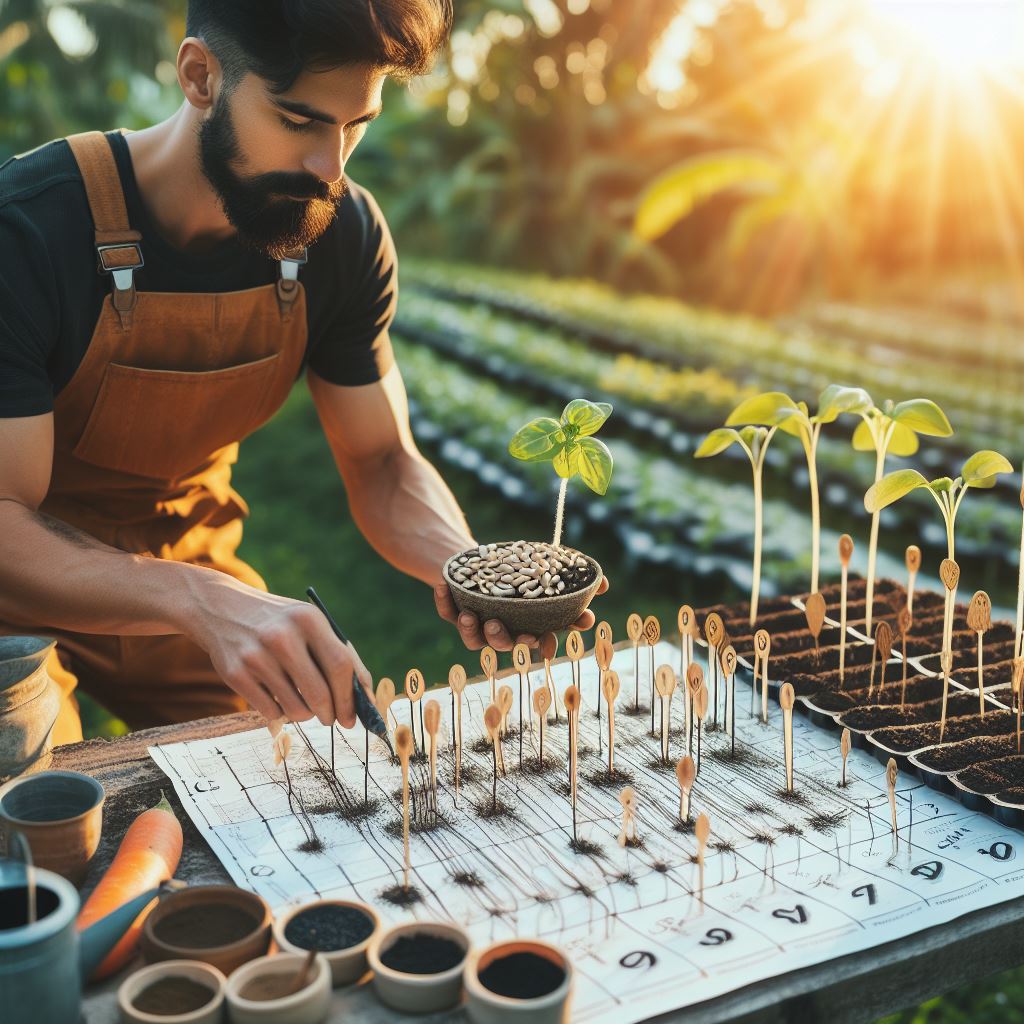Introduction
Soil health is the foundation of a thriving ecosystem.
Without healthy soil, plants struggle to grow and the entire ecosystem suffers.
One of the most effective ways to enhance soil health is through composting.
Composting is the process of decomposing organic materials, such as food scraps and yard waste, into nutrient-rich soil amendments.
By recycling organic waste back into the soil, composting replenishes important nutrients, improves soil structure, and promotes beneficial microbial activity.
This blog post will delve into the importance of soil health for plant growth and ecosystem sustainability.
It will also explore the various benefits of composting and how it can enhance soil fertility.
Additionally, it will provide practical tips on how to start composting at home and how to use compost to improve your garden soil.
By understanding the significance of soil health and the role of composting, readers will gain valuable insights on how to create a sustainable gardening routine.
The post will highlight the environmental advantages of composting, such as reducing landfill waste and minimizing the need for synthetic fertilizers.
In fact, this blog post aims to educate readers on the importance of soil health and the role composting plays in enhancing it.
By implementing composting practices, individuals can contribute to a healthier environment while reaping the benefits of healthier, more productive gardens.
What is Composting
Definition and Basic Concept
Composting is the process of decomposing organic materials, such as food scraps, yard waste, and leaves, into nutrient-rich soil.
The basic concept of composting involves creating an ideal environment for microorganisms to break down organic matter.
Compost is a dark, crumbly material that resembles and smells like rich soil.
It is a natural fertilizer.
Benefits of Composting
Composting has numerous benefits for both the environment and gardeners.
- Reduces waste: Composting diverts organic waste from landfills, reducing methane emissions and greenhouse gas production.
- Improves soil structure: Compost improves soil structure by enhancing water retention and aeration, leading to healthier plants.
- Enriches soil: Compost adds vital nutrients, such as nitrogen, potassium, and phosphorus, to the soil, promoting plant growth.
- Suppresses diseases and pests: The beneficial microorganisms present in compost help suppress plant diseases and pests naturally.
- Saves money: By using compost as a natural fertilizer, gardeners can reduce their reliance on expensive synthetic fertilizers.
Different Types of Composting Methods
- Traditional Composting: This method involves creating a pile of organic materials in a designated composting area.
- Vermicomposting: Vermicomposting uses worms to decompose organic matter, such as kitchen scraps, creating high-quality compost known as “worm castings.”
- Bokashi Composting: Bokashi composting utilizes a special mix of beneficial microorganisms to ferment food waste rapidly.
- Trench Composting: Trench composting involves digging a trench in the garden and burying organic waste directly into the ground.
- Compost Tea: Compost tea is made by steeping compost in water, creating a liquid fertilizer that can be applied to plants.
- Hot Composting: Hot composting involves creating larger compost piles that generate high temperatures, speeding up the decomposition process.
- Cold Composting: Cold composting takes longer as it relies on natural decomposition processes without active management.
- Community Composting: Community composting involves multiple households or a community collectively managing a composting system.
Regardless of the method chosen, keep in mind the basic principles of composting:
- Balance the carbon to nitrogen ratio (C/N ratio) in the compost pile to aid decomposition.
- Maintain proper moisture levels by regularly watering and covering the pile to prevent it from drying out or getting too wet.
- Provide adequate aeration by turning the compost pile regularly or using a composting system with built-in aeration mechanisms.
- Avoid adding meat, dairy products, and oily/greasy materials to the compost pile to prevent odors and attract pests.
In general, composting is an effective and sustainable way to enhance soil health and reduce waste.
By understanding the basics of composting, exploring different methods, and following good practices, anyone can enjoy the benefits of nutrient-rich compost and contribute to a healthier environment.
Getting started with composting
Choosing a composting site
- Location: Select a site that has good drainage and receives partial sun to promote decomposition.
- Accessibility: Ensure easy access to the compost pile for adding materials and turning them.
- Proximity to water source: Position the site near a water source for easy moistening of the compost pile.
Required materials and equipment
- Organic waste: Collect kitchen scraps, yard trimmings, leaves, and other organic material that can decompose.
- Carbon-rich material: Gather dry leaves, straw, sawdust, or shredded paper to balance the nutrient content.
- Composting bin: Choose a suitable bin or container to hold the compost pile, keeping it contained and organized.
- Pitchfork or shovel: Use a long-handled tool to turn the compost pile regularly, allowing for proper aeration.
- Thermometer (optional): Use a composting thermometer to monitor the internal temperature of the pile.
Preparing the composting bin
- Choosing the bin: Select a bin that suits your needs, such as a plastic bin, wire mesh container, or wooden box.
- Size: Ensure the bin is an adequate size to accommodate your composting needs, allowing for expansion over time.
- Ventilation: Ensure the bin has proper ventilation holes or slots to allow airflow for decomposition.
- Layering: Start with a layer of coarse materials like twigs or straw to aid in drainage and aeration.
- Add organic waste: Begin adding organic waste, alternating with carbon-rich materials in layers.
- Watering: Moist the layers as you add them, ensuring the pile remains damp but not overly wet.
- Turning: Regularly turn the pile using a pitchfork or shovel to mix the materials and promote decomposition.
- Monitoring: Keep an eye on the compost pile’s temperature and moisture content to ensure optimal conditions.
In a nutshell, starting composting involves selecting the right site, gathering necessary materials, and preparing the composting bin.
By choosing a suitable location, gathering organic waste and balancing it with carbon-rich material, and setting up a well-ventilated and properly layered bin, you can create a thriving compost pile.
Regularly turning the pile and monitoring its temperature and moisture levels will promote decomposition and enhance your soil.
Composting is a sustainable practice that not only helps reduce waste but also enriches your soil, making it an essential skill to learn for any gardener or environmentally conscious individual.
Read: Summer Garden Care: Beat the Heat!
The Composting Process
Composting is a natural and sustainable way to enhance your soil’s fertility and promote a healthier garden ecosystem.
Understanding the composting process is crucial for successful composting.
In this section, we will explore the key aspects, including the importance of nitrogen-rich vs. carbon-rich materials, ideal composting ratios, layering, turning the compost, and monitoring compost temperature and moisture levels.
Nitrogen-rich vs. carbon-rich materials
When it comes to composting, understanding the difference between nitrogen-rich “green” materials and carbon-rich “brown” materials is crucial.
Nitrogen-rich materials, such as grass clippings, food scraps, and manure, are essential for microbial activity, as they provide the necessary nutrients for decomposition.
On the other hand, carbon-rich materials, like dry leaves, straw, and wood chips, contribute to the compost’s structure and aeration.
Transform Your Agribusiness
Unlock your farm's potential with expert advice tailored to your needs. Get actionable steps that drive real results.
Get StartedIdeal ratios for composting
Achieving the right balance between nitrogen and carbon is vital for successful composting.
The ideal carbon-to-nitrogen (C:N) ratio is approximately 30:1.
This balance ensures there is enough carbon for structure while providing sufficient nitrogen for microbial decomposition.
Too much carbon can slow down the process, while an excess of nitrogen may cause unpleasant odors.
By maintaining the right ratio, you can maximize the effectiveness of your compost pile.
Layering and turning the compost
Layering your compost pile with alternating nitrogen-rich and carbon-rich materials is an effective way to enhance decomposition.
Start with a layer of carbon-rich materials as the base, followed by a layer of nitrogen-rich materials, and repeat the process until your pile reaches the desired size.
Additionally, regularly turning the compost pile is essential.
Turning mixes the materials, ensures proper moisture distribution, and introduces oxygen, facilitating the decomposition process.
Monitoring compost temperature and moisture level
Monitoring the temperature and moisture level of your compost pile allows you to assess its progress and make necessary adjustments.
The composting process generates heat as a result of microbial activity.
Aim for a temperature range of 120-150°F (49-66°C), as it promotes efficient decomposition and helps eliminate weed seeds and pathogens.
Additionally, regularly check the moisture level by squeezing a handful of compost. It should resemble a damp sponge.
Adjust the moisture by adding water if it’s too dry or incorporating dry carbon-rich materials if it’s too wet.
Ensuring you have a proper understanding of the composting process is key to producing nutrient-rich compost for your garden.
By using nitrogen-rich and carbon-rich materials, maintaining ideal ratios, layering and turning the compost, and monitoring temperature and moisture levels, you can create a thriving compost pile that enhances your soil and supports healthy plant growth.
Read: Urban Farm Water-Saving: Top 5 Effective Methods

Materials suitable for composting
Organic kitchen waste
One of the most common materials suitable for composting is organic kitchen waste.
This includes fruit and vegetable scraps, coffee grounds, tea bags, and eggshells.
These materials provide valuable nutrients and organic matter to your compost pile.
Yard and garden waste
Yard and garden waste such as grass clippings, leaves, and small branches are excellent additions to compost.
Ensure that these materials are free from any pesticides or chemicals that may harm the composting process.
Using yard and garden waste not only reduces landfill waste but also enriches the soil in your garden.
Adding coffee grounds, tea bags, and eggshells
Coffee grounds, tea bags, and eggshells are specifically beneficial for composting.
Coffee grounds provide nitrogen, tea bags add organic matter, and eggshells contribute calcium to the compost.
These items also help improve the texture and fertility of the soil when the compost is applied.
Incorporating shredded newspaper and cardboard
Shredded newspaper and cardboard are excellent sources of carbon for composting.
They help create a well-balanced compost mixture by balancing the nitrogen-rich materials with carbon-rich materials.
Before adding newspaper or cardboard, ensure they are free from any glossy coatings or colored inks.
Overall, composting provides a sustainable solution for managing and enriching your soil.
By utilizing materials such as organic kitchen waste, yard and garden waste, coffee grounds, tea bags, eggshells, shredded newspaper, and cardboard, you can create nutrient-rich compost that enhances the fertility of your soil.
Remember to turn and moisten the compost regularly to provide the necessary conditions for decomposition.
Composting is not only beneficial for your garden but also for the environment by reducing landfill waste and minimizing the need for chemical fertilizers.
Start composting today and witness the transformation of your soil and the health of your plants!
Read: Marigolds: More Than Just Pretty
What not to compost
Meat, dairy, and oily foods
Composting is a great way to reduce waste and enrich your soil with valuable nutrients.
However, not everything can be composted.
It is important to know what not to compost in order to maintain a healthy and effective composting system.
Showcase Your Farming Business
Publish your professional farming services profile on our blog for a one-time fee of $200 and reach a dedicated audience of farmers and agribusiness owners.
Publish Your ProfileAvoid composting meat, dairy, and oily foods as they can attract pests and create unpleasant odors.
These products can also take longer to break down, which can disrupt the composting process.
Diseased plants and weeds with seeds
While it may be tempting to compost diseased plants and weeds, it is best to avoid doing so.
Diseases and weed seeds can survive the composting process and spread to your garden when the compost is used.
To prevent the spread of diseases and weeds, it is recommended to dispose of them in a separate manner, such as burning or disposing of them in a sealed bag.
Synthetic materials and chemicals
Synthetic materials and chemicals should never be composted.
These include plastics, rubber, metals, and any products that contain harmful chemicals or heavy metals.
Composting synthetic materials can lead to contamination of the soil and harm the beneficial organisms that help break down organic matter.
To ensure a safe and natural composting process, stick to organic materials such as fruit and vegetable scraps, leaves, grass clippings, and coffee grounds.
By avoiding composting meat, dairy, and oily foods, diseased plants and weeds with seeds, as well as synthetic materials and chemicals, you can maintain a healthy and effective composting system.
Remember to always add a good mix of greens (nitrogen-rich materials) and browns (carbon-rich materials) to your compost pile to create a balanced environment for decomposition.
Greens include items such as fruit and vegetable scraps, grass clippings, and coffee grounds, while browns include dry leaves, straw, and shredded paper.
Regularly turning or aerating the compost pile will also help speed up the decomposition process and prevent unpleasant odors.
With a little care and attention, you can create nutrient-rich compost to enhance your soil and promote healthy plant growth.
So remember, know what not to compost and focus on organic materials for a successful composting experience!
Read: Soil Health for Pest/Disease Control
Troubleshooting compost pile issues
Foul odors and pest problems
- Foul odors indicate an imbalance in the compost pile, caused by too much nitrogen-rich material.
- To combat foul odors, add more carbon-rich materials such as dry leaves, shredded paper, or straw.
- Avoid adding meat, dairy, or oily food scraps, as they attract pests like rodents and flies.
- If pests are a problem, consider using a secure compost bin or covering the pile with a thick layer of carbon-rich material.
Slowing down or speeding up the composting process
- If your compost is taking too long to decompose, the pile might lack oxygen.
- Ensure proper aeration by turning the pile regularly or using a compost aerator tool.
- Adding more nitrogen-rich materials or using a compost activator can also speed up the process.
- Alternatively, if the compost is decomposing too quickly, it might be too hot or lacks structure.
- Add more carbon-rich materials and moisten the pile to cool it down and slow down the decomposition.
Balancing moisture and temperature
- A compost pile should be moist but not waterlogged. If it’s too wet, it will become anaerobic and produce foul odors.
- To balance moisture, add dry carbon-rich materials and turn the pile to allow air circulation.
- If the pile is too dry, sprinkle water over it while turning to ensure proper decomposition.
- Monitoring the temperature is vital for successful composting. The ideal range is between 120°F and 160°F.
- Use a compost thermometer to check the temperature and adjust the pile’s moisture and aeration as needed.
By addressing these common compost pile issues, you can maintain a healthy and productive composting process.
Troubleshooting problems helps ensure that your organic waste transforms into nutrient-rich soil amendment for your plants.
See Related Content: Balcony Farming: Small Space Ideas
Harvesting and using compost
Harvesting and utilizing compost is a critical step in the composting process.
After patiently waiting for decomposition to occur, it is finally time to reap the rewards of your hard work.
This section explores the signs of fully composted material, techniques for harvesting compost, and various ways to incorporate this precious resource into your garden.
Signs of fully composted material
Determining if your compost is fully decomposed is essential to ensure its effectiveness when used in the garden.
Here are some signs to look for:
- Dark and crumbly texture: Well-composted material should have a dark color and crumbly texture, resembling rich soil. It should be easy to break apart.
- Earthy smell with no unpleasant odors: Properly composted material will have a pleasant, earthy smell, similar to fresh soil. Foul or ammonia-like odors indicate unfinished compost.
- Absence of recognizable organic materials: Fully composted material should not contain any recognizable organic materials, such as food scraps or leaves. It should be a uniform mixture without any large chunks.
Techniques for harvesting compost
Once your compost reaches the desired state, you can employ different techniques to harvest it effectively:
- Screening: Pass your compost through a mesh screen or use a compost sifter to remove any large debris or unfinished materials. This will result in a finer, more consistent product.
- Pile turning: Regularly turn your compost pile using a pitchfork or shovel. This helps incorporate oxygen, which speeds up decomposition and ensures all materials are fully composted.
- Use a compost tumbler: Consider using a compost tumbler, a container that can be rotated easily. By spinning the tumbler, you can mix and aerate the compost, accelerating the process.
Incorporating compost into the garden
Once you have harvested your compost, it’s time to put it to good use in your garden.
Here are different techniques for incorporating compost:
- Topdressing: Spread a thin, even layer of compost on top of the soil surface around your plants. This provides a slow-release source of nutrients and helps improve soil structure.
- Mulching: Apply a layer of compost as mulch around your plants. This helps retain moisture in the soil, suppresses weeds, and gradually releases nutrients as it breaks down.
- Mixing: Prior to planting, dig compost into your existing garden beds or vegetable rows. This ensures the compost is thoroughly integrated into the soil, promoting healthy plant growth.
By following these techniques for harvesting and incorporating compost, you can maximize the benefits of this organic fertilizer and enhance the overall health of your garden.
Conclusion
Recap of key points
Composting is a simple and effective way to enhance soil health and promote sustainable farming.
It involves the decomposition of organic materials, such as kitchen scraps, yard waste, and manure, into nutrient-rich compost.
Encouragement to start composting
By composting, you can reduce waste, save money on fertilizers, and improve the quality of your soil.
It is a rewarding and environmentally friendly activity that anyone can start, regardless of their gardening experience or space availability.
Importance of soil health for sustainable farming
Soil health is vital for sustainable farming because it affects crop growth, water retention, and nutrient availability.
Compost adds essential nutrients, improves soil structure, and encourages the growth of beneficial microbes.
Healthy soil leads to more abundant and resilient crops, reducing the need for chemical fertilizers and pesticides.
Starting your own compost pile is a small step that can make a big difference in preserving our environment and promoting sustainable agriculture.
By recycling organic waste into nutrient-rich compost, you are contributing to a healthier planet and ensuring the future of farming.
Remember to layer your compost materials, keep it moist, and turn it occasionally to speed up the decomposition process.
With patience and dedication, you will soon have a black, crumbly compost that can be used to enrich your garden beds, potted plants, or even lawns.
Join the composting movement today and become part of a growing community of environmentally conscious individuals.
Whether you live in an apartment or have acres of land, composting is a sustainable practice that benefits us all.
Let’s work together to enhance our soil, reduce waste, and create a greener future for generations to come.




